 Abraham Lincoln
If given the truth, the people can be depended upon to meet any national crisis...
Abraham Lincoln
If given the truth, the people can be depended upon to meet any national crisis...
 Guildford news...
for Guildford people, brought to you by Guildford reporters - Guildford's own news service
Guildford news...
for Guildford people, brought to you by Guildford reporters - Guildford's own news service
Fascinating Pictures and Details of an Aussie Soldier Convalescing in Guildford During First World War
Published on: 14 Dec, 2016
Updated on: 17 Dec, 2016
By David Rose
During the First World War, Guildford’s workhouse in Warren Road was taken over as a military war hospital. The historians at today’s Spike heritage centre on the site of the former workhouse (later St Luke’s Hospital) continue to do much important research into the servicemen who were treated there. It is now known that it included a large number of Australians.
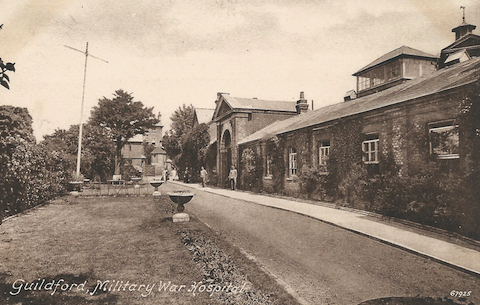
Picture postcard view of the Guildford Military War Hospital, Warren Road, during the First World War.
Graeme Stevens, from Melbourne, Australia, has emailed The Guildford Dragon NEWS with details of his father who was treated at the Guildford Military War Hospital, plus some fascinating photographs.
He writes: “My father, Albert Stevens, of the 58th Battalion First Australian Imperial Force (AIF), was a limbless soldier having lost a leg at the battle of Polygon Wood in September 1917. His records indicate that he was hospitalised at the Guildford Military War Hospital from October 1917 to February 1918.”
I have been able to assist Graeme with his research emailing him picture postcard views of the war hospital and putting him in contact with the historians at the Spike.
Writing in my book, Great War Britain, Remembering Guildford 1914-18 (published by The History Press in 2014), I noted: “Under the supervision of temporary Lieutenant Colonel Herbert Powell, Royal Army Medical Corps (RAMC), the Warren Road military hospital opened in March 1916. Doctors from Guildford initially formed the medical staff until a RAMC surgeon and female doctors took over later.
“It was the largest of Guildford’s wartime military hospitals, with 300 beds, later increasing to 480 beds. Eighty nurses attended to the patients, supported by a number of orderlies and clerks, including existing workhouse staff, who retained their civilian status.
“From the early part of 1918 it was mostly used to treat cases of malaria, and closed in May 1919, having treated 7,680 patients, a number of Australian servicemen among them.”
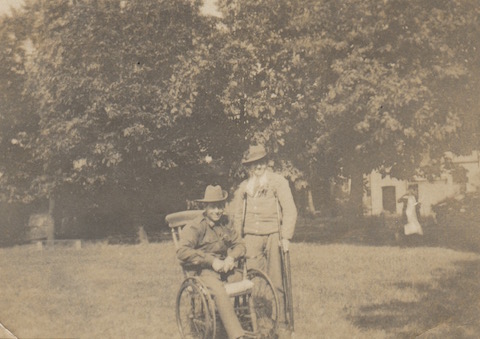
From Graeme Stevens ‘Guildford War Hospital 1’ – a photo of two Aussie soldiers in the grounds of the hospital. The soldier standing is Graeme’s father Albert Stevens.
Graham adds: “My picture ‘Guildford War Hospital 1’ is a photo of two Aussie soldiers in the grounds of the hospital. The soldier standing is my father. I guess this photo would have been taken early 1918. From the photos you sent me I can now visualise the buildings in the background.”
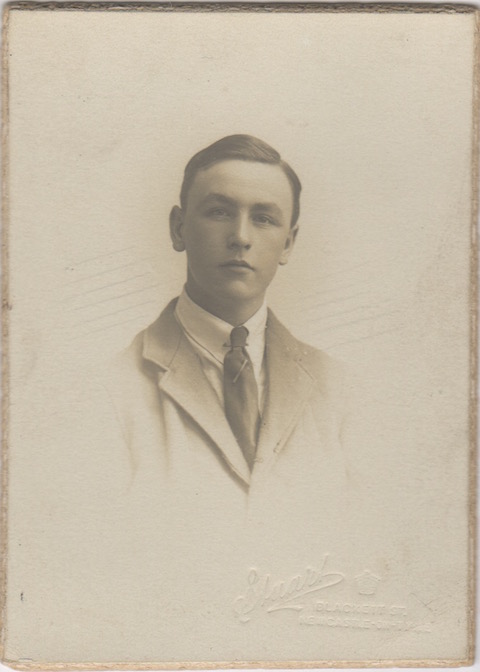
Thought by Graeme Stevens to perhaps be a nurse at the Guildford Military War Hospital, Dryden Anderson may well have been a patient.
“Of the pictures, ‘Guildford War Hospital Nurse and Nurse 1’. I presume that this is either a nurse or doctor that befriended Dad. ‘Nurse 1 photo’ has some words written on the back of the photograph. The nurse/doctor’s name was Dryden Anderson.”
Ian Nicholls of Charlotteville, who has researched the names on the war memorial in Addison Road, and has a keen interest in the First World War has been copied into Graeme’s emails.
However, he adds: “I wonder if Dryden Andersen was patient/soldier? There is an army service record for a Dryden Cooper Anderson who was from South Shields and who was invalided out in 1918 aged about 20. This would tie in with Graeme’s photo. The service record says he was wounded in the shoulder in action (France), but unfortunately there is no mention he was ever at the Guildford Military War Hospital.
“The message on back of the photo of refers to F4, presumably the ward they were in?”
Note the impression on the photo of the photographer – of Blacknett St, Newcastle-on-Tyne. Surely it is the same person as traced by Ian?
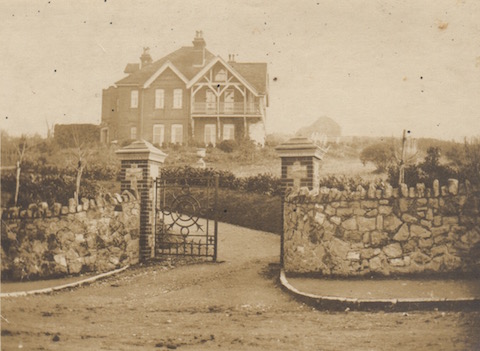
Grame notes this picture as ‘Guildford War Hospital’. It is definitely not the workhouse building and looks to be a house in perhaps Warwick’s Bench, Guildford? See telegram further on.
Back to Graeme and the picture he notes as ‘Guildford War Hospital’. He writes: “This photograph was in Dad’s papers with no notation of what it was. During the period of convalescent many of the injured soldiers were taken in as guests of locals in their private homes. I presume that this house was one that Dad may have stayed in and that it was in the Guildford area. Sorry, but I cannot provide you with any other information.
The next clue is in the photo he has named a ‘Telegram 18’ – and it suggests the house was in Warwick’s Bench, Guildford. Is it still there? The historians at the Spike are looking into this as it is known that large houses in the area were commandeered to house soldiers while convalescing.
Of the picture ‘Telegram 1918’, Graeme notes: “Again this was in Dad’s papers. He was transferred to the Australian Auxiliary Hospital at Southall, London, early 1918. He was on furlough from that hospital in October 1918 and I have included it for your interest as it was addressed to Dad at Warwick’s Bench Guildford. Dr Google tells me that Warwick’s Bench is the name of a road in Guildford. Is this the road the hospital is in as I presumed that he had returned to Guildford to catch up with some of his friends at the hospital?
Of course, we know that the Guildford Military War Hospital was in Warren Road (originally Union Road, but changed to the latter because of the stigma of children being born at the workhouse and the place of the birth being given on birth certificates as Union Road and a giveaway that they had been born as paupers).
Therefore it seems that this house in Warwick’s Bench (so named after a carpenter who once had his workshop thereabouts) was used to house convalescing servicemen, but not far from the Guildford Military War Hospital, or others in Guildford such as the Royal Surrey County Hospital in Farnham Road and the Red Cross annexe wartime hospital (now the County School) also in Farnham Road.
Of the The First Australian Imperial Force (1st AIF). Wikipedia notes: “It was the main expeditionary force of the Australian Army during World War I.
“It was formed on 15 August 1914, following Britain’s declaration of war on Germany, initially with a strength of one infantry division and one light horse brigade.
“The infantry division subsequently fought at Gallipoli between April and December 1915, being reinforced by a second division which was later raised, as well as three light horse brigades.
“After being evacuated to Egypt the AIF was expanded to five infantry divisions, which were committed to the fighting in France and Belgium along the Western Front in March 1916.
“A sixth infantry division was partially raised in 1917 in the United Kingdom, but was broken up and used as reinforcements following heavy casualties on the Western Front. Meanwhile, two mounted divisions remained in the Middle East to fight against Turkish forces in the Sinai and Palestine.”
Responses to Fascinating Pictures and Details of an Aussie Soldier Convalescing in Guildford During First World War
Leave a Comment Cancel replyPlease see our comments policy. All comments are moderated and may take time to appear.
Recent Articles
- Guildford Institute’s Crowdfunding Project for Accessible Toilet in its New Community and Wellbeing Centre
- Letter: Guildford – Another Opportunity Missed?
- Letter: GBC’s Corporate Strategy – Where Is the Ambition?
- My Memories of John Mayall at a Ground-breaking Gig in Guildford Nearly Six Decades Ago
- Westborough HMO Plans ‘Losing the Heart of the Street’ Says Resident
- College Invests to Boost Surrey’s Economy and Close Digital Skills Gap
- Community Lottery Brings Big Wins for Local Charities
- GBC Housing Plan Promises ‘A Vibrant Urban Neighbourhood’ Near Town Centre
- Hospital Pillows ‘Shortage’ at the Royal Surrey
- Updated: Caravans Set Up Camp at Ash Manor School


Recent Comments
- Ian Macpherson on Updated: Main Guildford to Godalming Road Closed Until August 1
- Sara Tokunaga on GBC Housing Plan Promises ‘A Vibrant Urban Neighbourhood’ Near Town Centre
- Michael Courtnage on Daily Mail Online Reports Guildford Has Highest-paid Council Officer
- Alan Judge on GBC Housing Plan Promises ‘A Vibrant Urban Neighbourhood’ Near Town Centre
- John Perkins on GBC Housing Plan Promises ‘A Vibrant Urban Neighbourhood’ Near Town Centre
- S Collins on GBC Housing Plan Promises ‘A Vibrant Urban Neighbourhood’ Near Town Centre
Search in Site
Media Gallery
Dragon Interview: Local Artist Leaves Her Mark At One of England’s Most Historic Buildings
January 21, 2023 / No Comment / Read MoreDragon Interview: Lib Dem Planning Chair: ‘Current Policy Doesn’t Work for Local People’
January 19, 2023 / No Comment / Read MoreA3 Tunnel in Guildford ‘Necessary’ for New Homes, Says Guildford’s MP
January 10, 2023 / No Comment / Read More‘Madness’ for London Road Scheme to Go Ahead Against ‘Huge Opposition’, Says SCC Leader
January 6, 2023 / No Comment / Read MoreCouncillor’s Son Starts Campaign for More Consultation on North Street Plan
December 30, 2022 / No Comment / Read MoreCounty Council Climbs Down Over London Road Works – Further ‘Engagement’ Period Announced
December 14, 2022 / No Comment / Read MoreDragon Interview: GBC Reaction to the Government’s Expected Decision to Relax Housing Targets
December 7, 2022 / No Comment / Read MoreHow Can Our Town Centre Businesses Recover? Watch the Shop Front Debate
May 18, 2020 / No Comment / Read More



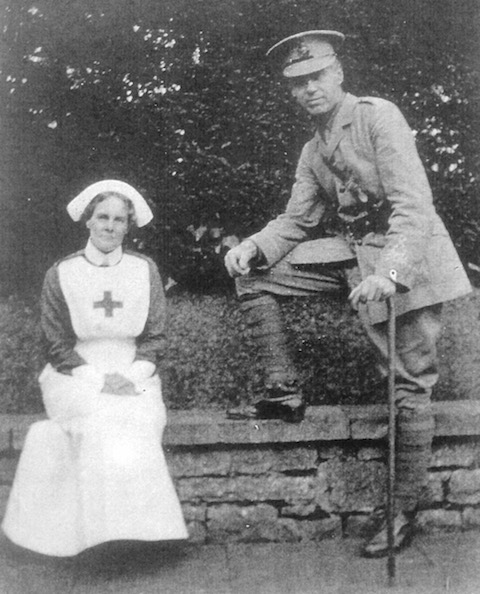
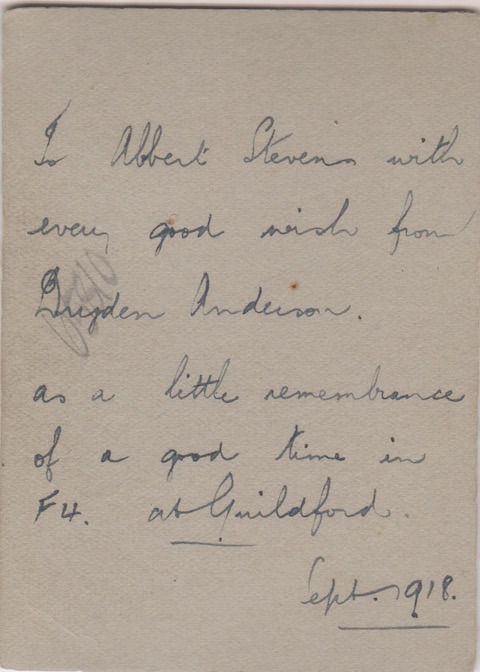
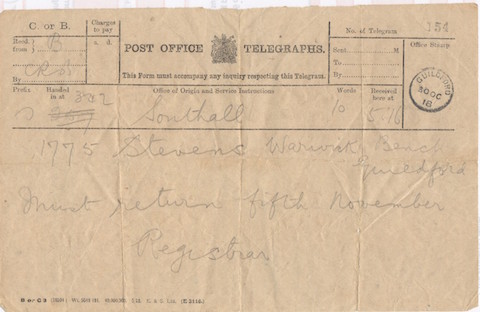






Ian Nicholls
December 14, 2016 at 12:45 pm
From their respective Army Service Records Albert Stevens, 58th Bn AIF, was admitted to Guildford War Hospital 16th October 1917.
Dryden Anderson, 9th Battalion West Yorks Regiment, was posted on 19th October 1917 to 98th Depot.
Does this mean that was when he was injured he never rejoined his unit?
The record is not very clear, but there is no mention of Guildford War Hospital.
But it could mean his pay was now the responsibility of the Depot Battalion.
If the two men were in the same ward at Guildford it does make you wonder how the Australian and the Geordie understood each other’s accents.
Ian Nicholls
January 10, 2017 at 1:04 pm
The house looks like no 15, Warwick’s Bench House, Warwick’s Bench. The house is still there but has been modified and extended and a smaller house built in front. It must have been one of the first houses in the road as an early postcard of it was featured in an earlier Guildford Dragon article about the history of Warwicks Bench written in September 2012. It was recently on the market for £1.19m
Graeme Stevens
January 25, 2017 at 7:25 am
Hi Ian, are you able to give me more information re the house at no 15? I am interested as to why my father had it in his records.
I initially assumed that he may have been a patient there as part of his recovery process in 1917/18.